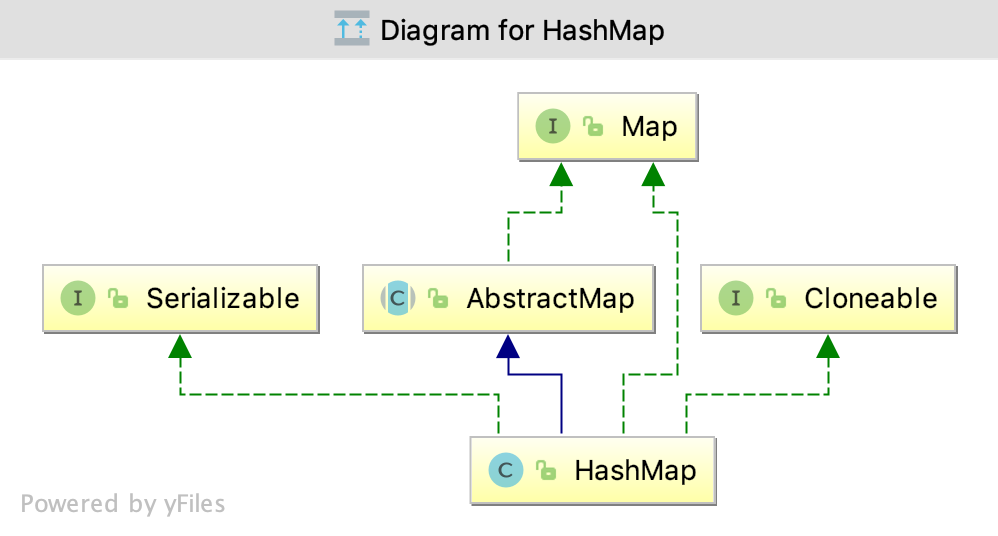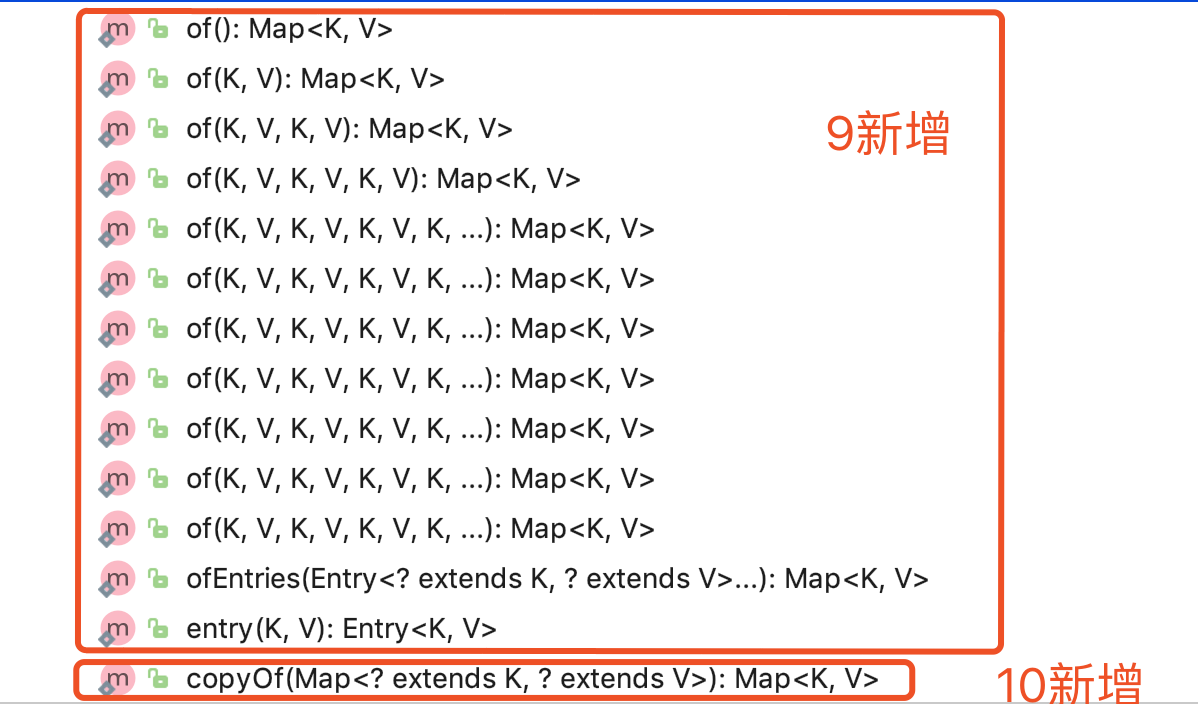v前言
之前读过一些类的源码,近来发现都忘了,再读一遍整理记录一下。这次读的是 JDK 11 的代码,贴上来的源码会去掉大部分的注释, 也会加上一些自己的理解。
vMap 接口
这里提一下 Map 接口与1.8相比 Map接口又新增了几个方法:
这些方法都是包私有的static方法;
of()方法分别返回包含 0 - 9 个键值对的不可修改的Map;ofEntries()方法返回包含从给定的entries总提取出来的键值对的不可修改的* Map(不会包含给定的entries);entry()方法返回包含键值对的不可修改的 Entry,不允许 null 作为 key 或 value;copyOf()返回一个不可修改的,包含给定 Map 的 entries 的 Map ,调用了ofEntries()方法.
v数据结构
HashMap 是如何存储键值对的呢?
HashMap 有一个属性 table:
transient Node<K,V>[] table;
table 是一个 Node 的数组, 在首次使用和需要 resize 时进行初始化; 这个数组的长度始终是2的幂, 初始化时是0, 因此能够使用位运算来代替模运算.
HashMap的实现是装箱的(binned, bucketed), 一个 bucket 是 table 数组中的一个元素, 而 bucket 中的元素称为 bin .
来看一下 Node , 很显然是一个单向链表:
static class Node<K,V> implements Map.Entry<K,V> { final int hash; final K key;
V value;
Node<K,V> next;
...
}当然, 我们都知道 bucket 的结构是会在链表和红黑树之间相互转换的:
// 转换成红黑树if (binCount >= TREEIFY_THRESHOLD - 1) // -1 for 1st treeifyBin(tab, hash);// 转换成链表结构if (lc <= UNTREEIFY_THRESHOLD) tab[index] = loHead.untreeify(map);
注意在 treeifyBin() 方法中:
// table 为 null 或者 capacity 小于 MIN_TREEIFY_CAPACITY 会执行 resize() 而不是转换成树结构if (tab == null || (n = tab.length) < MIN_TREEIFY_CAPACITY) resize();
TreeNode 的结构和 TreeMap 相似, 并且实现了 tree 版本的一些方法:
static final class TreeNode<K,V> extends LinkedHashMap.Entry<K,V> {
TreeNode<K,V> parent; // red-black tree links
TreeNode<K,V> left;
TreeNode<K,V> right;
TreeNode<K,V> prev; // needed to unlink next upon deletion
boolean red;
...
}vinitialCapacity 和 loadFactor
先看一下 HashMap 的4个构造器,可以发现3个重要的 int :threshold,initialCapacity 和 loadFactor ,其中 threshold 和 loadFactor 是 HashMap 的私有属性。
HashMap 的 javadoc 中有相关的解释:
capacity,HashMap 的哈希表中桶的数量;
initial capacity ,哈希表创建时桶的数量;
load factor ,在 capacity 自动增加(
resize())之前,哈希表允许的填满程度;threshold,下一次执行
resize()时 size 的值 (capacity * load factor),如果表没有初始化,存放的是表的长度,为0时表的长度将会是DEFAULT_INITIAL_CAPACITY。
注意: 构造器中的 initialCapacity 参数并不是 table 的实际长度, 而是期望达到的值, 实际值一般会大于等于给定的值. initialCapacity 会经过tableSizeFor() 方法, 得到一个不大于 MAXIMUM_CAPACITY 的足够大的2的幂, 来作为table的实际长度:
static final int tableSizeFor(int cap) { int n = -1 >>> Integer.numberOfLeadingZeros(cap - 1); return (n < 0) ? 1 : (n >= MAXIMUM_CAPACITY) ? MAXIMUM_CAPACITY : n + 1;
}loadFactor 的默认值是 0.75f :
static final float DEFAULT_LOAD_FACTOR = 0.75f;
initialCapacity 的默认值是16:
static final int DEFAULT_INITIAL_CAPACITY = 1 << 4; // aka 16
capacity 的最大值是1073741824:
static final int MAXIMUM_CAPACITY = 1 << 30;
在 new 一个 HasMap 时,应该根据 mapping 数量尽量给出 initialCapacity , 减少表容量自增的次数 . putMapEntries() 方法给出了一种计算 initialCapacity 的方法:
float ft = ((float)s / loadFactor) + 1.0F;int t = ((ft < (float)MAXIMUM_CAPACITY) ? (int)ft : MAXIMUM_CAPACITY);if (t > threshold) threshold = tableSizeFor(t);
这段代码里的 t 就是 capacity .
vhash() 方法
hash() 是 HashMap 用来计算 key 的 hash 值的方法, 这个方法并不是直接返回 key 的 hashCode() 方法的返回值, 而是将 hashCode 的高位移到低位后 再与原值异或.
static final int hash(Object key) { int h; return (key == null) ? 0 : (h = key.hashCode()) ^ (h >>> 16);
} 因为 HashMap 用 hash & (table.length-1)代替了 模运算 , 如果直接使用 hashCode() 的返回值的话, 只有hash code的低位(如果 table.length 是2的n次方, 只有最低的 n - 1 位)会参加运算, 高位即使发生变化也会产生碰撞. 而 hash() 方法把 hashCode 的高位与低位异或, 相当于高位也参加了运算, 能够减少碰撞.
举个例子:
假设 table.length - 1 的 值为 0000 0111, 有两个hash code : 0001 0101 和 0000 0101. 这两个hash code 分别与 table.length - 1 做与运算之后的结果是一样的: 0000 0101; 将这两个hash code 的高位和低位异或之后分别得到: 0001 0100、 0000 0101, 此时再分别与 table.length - 1 做与运算的结果是 0000 0100 和 0000 0101, 不再碰撞了.
vresize()
resize() 方法负责初始化或扩容 table. 如果 table 为 null 初始化 table 为 一个长度为 threshold 或 DEFAULT_INITIAL_CAPACITY的表; 否则将 table 的长度加倍, 旧 table 中的元素要么呆在原来的 index 要么以2的幂为偏移量在新 table中移动:
final Node<K,V>[] resize() {
Node<K,V>[] oldTab = table; int oldCap = (oldTab == null) ? 0 : oldTab.length; int oldThr = threshold; int newCap, newThr = 0; if (oldCap > 0) { if (oldCap >= MAXIMUM_CAPACITY) { // 旧 table 的容量已经达到最大, 不扩容, 返回旧表
threshold = Integer.MAX_VALUE; return oldTab;
} else if ((newCap = oldCap << 1) < MAXIMUM_CAPACITY &&
oldCap >= DEFAULT_INITIAL_CAPACITY) // 将旧容量加倍作为新表容量, 如果新表容量没达到容量最大值, 并且旧容量大于等于默认容量, threshold 加倍
newThr = oldThr << 1; // double threshold } else if (oldThr > 0) // initial capacity was placed in threshold // 旧的threshold 不为 0 , 旧 threshold 作为新表的容量
newCap = oldThr; else { // zero initial threshold signifies using defaults // 旧 threshold 为 0 , 用 DEFAULT_INITIAL_CAPACITY 作为新容量, 用默认值计算新 threshold
newCap = DEFAULT_INITIAL_CAPACITY;
newThr = (int)(DEFAULT_LOAD_FACTOR * DEFAULT_INITIAL_CAPACITY);
} if (newThr == 0) { // 之前没有计算过新 threshold , 计算 threshold
float ft = (float)newCap * loadFactor;
newThr = (newCap < MAXIMUM_CAPACITY && ft < (float)MAXIMUM_CAPACITY ?
(int)ft : Integer.MAX_VALUE);
}
threshold = newThr;
@SuppressWarnings({"rawtypes","unchecked"}) // 创建新表数组, 更新表引用
Node<K,V>[] newTab = (Node<K,V>[])new Node[newCap];
table = newTab; if (oldTab != null) { // 将旧表中的元素移动到新表
for (int j = 0; j < oldCap; ++j) { // 遍历旧表
Node<K,V> e; if ((e = oldTab[j]) != null) { // 帮助 GC
oldTab[j] = null; if (e.next == null) // 这个桶里只有一个元素, 此处用位运算代替了模运算
newTab[e.hash & (newCap - 1)] = e; else if (e instanceof TreeNode) // 如果这个 bucket 的结构是树, 将这个 bucket 中的元素分为高低两部分((e.hash & bit) == 0 就分在低的部分, bit 是 oldCap), 低的部分留在原位, 高的部分放到 newTab[j + oldCap]; 如果某一部分的元素个数小于 UNTREEIFY_THRESHOLD 将这一部分转换成链表形式, 否则就形成新的树结构
((TreeNode<K,V>)e).split(this, newTab, j, oldCap); else { // preserve order // 将普通结构的 bucket 中的元素分为高低两部分, 低的部分留在原位, 高的部分放到 newTab[j + oldCap]
Node<K,V> loHead = null, loTail = null;
Node<K,V> hiHead = null, hiTail = null;
Node<K,V> next; do {
next = e.next; if ((e.hash & oldCap) == 0) { if (loTail == null)
loHead = e; else
loTail.next = e;
loTail = e;
} else { if (hiTail == null)
hiHead = e; else
hiTail.next = e;
hiTail = e;
}
} while ((e = next) != null); if (loTail != null) {
loTail.next = null;
newTab[j] = loHead;
} if (hiTail != null) {
hiTail.next = null;
newTab[j + oldCap] = hiHead;
}
}
}
}
} return newTab;
}举个例子解释一下高低两部分的划分:
扩容前 table.length 是 0000 1000 记为 oldCap , table.length - 1 是 0000 0111 记为 oldN;
扩容后 table.length 是 0001 0000 记为 newCap, table.length - 1 为 0000 1111 记为 newN;
有两个Node, hash (
hash()方法得到的值)分别为 0000 1101 和 0000 0101 记为 n1 和 n2;
在扩容前, n1 和 n2 显然是在一个 bucket 里的, 但在扩容后 n1 & newN 和 n2 & newN 的值分别是 0000 1101 和 0000 0101, 这是需要划分成两部分, 并且把属于高部分的 bin 移动到新的 bucket 里的原因.
扩容后, hash 中只会有最低的4位参加 index 的计算, 因此可以用第4位来判断属于高部分还是低部分, 也就可以用 (hash & oldCap) == 0 来作为属于低部分的依据了.
v查找
查找方法只有 get() 和 getOrDefault() 两个, 都是调用了 getNode()方法:
public V get(Object key) {
Node<K,V> e; return (e = getNode(hash(key), key)) == null ? null : e.value;
}
@Overridepublic V getOrDefault(Object key, V defaultValue) {
Node<K,V> e; return (e = getNode(hash(key), key)) == null ? defaultValue : e.value;
}vgetNode() 方法
final Node<K,V> getNode(int hash, Object key) {
Node<K,V>[] tab; Node<K,V> first, e; int n; K k; if ((tab = table) != null && (n = tab.length) > 0 &&
(first = tab[(n - 1) & hash]) != null) { // table 已经被初始化且 table 的长度不为 0 且 对应的 bucket 里有 bin
if (first.hash == hash && // always check first node
((k = first.key) == key || (key != null && key.equals(k)))) // 第一个节点的 key 和 给定的 key 相同
return first; if ((e = first.next) != null) { // bucket 中还有下一个 bin
if (first instanceof TreeNode) // 是树结构的 bucket, 调用树版本的 getNode 方法
return ((TreeNode<K,V>)first).getTreeNode(hash, key); do { // 在普通的链表中查找 key
if (e.hash == hash &&
((k = e.key) == key || (key != null && key.equals(k)))) return e;
} while ((e = e.next) != null);
}
} return null;
}v遍历
可以通过entrySet()、keySet()、values()分别获得 EntrySet、KeySet()和Values对象, 他们的迭代器都是HashIterator的子类.
vfast-fail 和 modCount
HashMap 不是线程安全的, 并且实现了 fast-fail 机制. 当一个迭代器被创建的时候(或者迭代器自身的 remove() 方法被调用), 会记录当前的 modCount 作为期待中的 modCount, 并在操作中先检查当前 modCount 是不是和旧的 modCount 相同, 不同则会抛出ConcurrentModificationException.
任何结构修改(新增或删除节点)都会改变 modCount 的值.
v新增和更新
1.8 之前有4个方法和构造器能够往 HashMap 中添加键值对: 以一个Map为参数的构造器、put()、putAll()、putIfAbsent(),
public HashMap(Map<? extends K, ? extends V> m) { this.loadFactor = DEFAULT_LOAD_FACTOR;
putMapEntries(m, false);
}public V put(K key, V value) { return putVal(hash(key), key, value, false, true);
}public void putAll(Map<? extends K, ? extends V> m) {
putMapEntries(m, true);
}
@Overridepublic V putIfAbsent(K key, V value) { return putVal(hash(key), key, value, true, true);
} 他们分别调用了putMapEntries()和putVal(). 这两个方法中有一个参数 evict , 仅当初始化时(构造器中)为 false.
vputVal() 方法
来看一下putVal() 方法:
final V putVal(int hash, K key, V value, boolean onlyIfAbsent, boolean evict) {
Node<K,V>[] tab; Node<K,V> p; int n, i; if ((tab = table) == null || (n = tab.length) == 0) // table 未被初始化或者长度为 0 时, 执行 resize()
n = (tab = resize()).length; if ((p = tab[i = (n - 1) & hash]) == null) // 对应的 bucket 里没有元素, 新建一个普通 Node 放到这个位置
tab[i] = newNode(hash, key, value, null); else {
Node<K,V> e; K k; if (p.hash == hash &&
((k = p.key) == key || (key != null && key.equals(k)))) // 第一个节点的 key 和 给定的 key 相同
e = p; else if (p instanceof TreeNode) // 树结构, 调用树版本的 putVal, 如果树结构中存在 key, 将会返回相应的 TreeNode, 否则返回 null
e = ((TreeNode<K,V>)p).putTreeVal(this, tab, hash, key, value); else { for (int binCount = 0; ; ++binCount) { if ((e = p.next) == null) { // 在链表中没有找到 key, 新建一个节点放到链表末尾
p.next = newNode(hash, key, value, null); if (binCount >= TREEIFY_THRESHOLD - 1) // -1 for 1st // 当前桶转换成树结构 treeifyBin(tab, hash); break;
} if (e.hash == hash &&
((k = e.key) == key || (key != null && key.equals(k)))) // key 相同 break
break;
p = e;
}
} if (e != null) { // existing mapping for key // key 在 map 中存在
V oldValue = e.value; if (!onlyIfAbsent || oldValue == null) // 覆盖旧值
e.value = value;
afterNodeAccess(e); return oldValue;
}
} // key 之前在 map 中不存在, 发生了结构变化, modCount 增加 1
++modCount; if (++size > threshold) // 扩容 resize();
afterNodeInsertion(evict); return null;
}HashMap 提供了三个回调方法:
void afterNodeAccess(Node<K,V> p) { }void afterNodeInsertion(boolean evict) { }void afterNodeRemoval(Node<K,V> p) { }vputMapEntries() 方法
putMapEntries()方法就简单多了
final void putMapEntries(Map<? extends K, ? extends V> m, boolean evict) { int s = m.size(); if (s > 0) { if (table == null) { // pre-size // table 还没有初始化, 计算出 threshold
float ft = ((float)s / loadFactor) + 1.0F; int t = ((ft < (float)MAXIMUM_CAPACITY) ?
(int)ft : MAXIMUM_CAPACITY); if (t > threshold)
threshold = tableSizeFor(t);
} else if (s > threshold) // s 超过了 threshold, 扩容 resize(); for (Map.Entry<? extends K, ? extends V> e : m.entrySet()) { // 调用 putVal() 方法, 将键值对放进 map
K key = e.getKey();
V value = e.getValue();
putVal(hash(key), key, value, false, evict);
}
}
}v删除
删除元素有三个方法, 还有 EntrySet 和 KeySet 的 remove 和 clear 方法:
public V remove(Object key) {
Node<K,V> e; return (e = removeNode(hash(key), key, null, false, true)) == null ? null : e.value;
}
@Overridepublic boolean remove(Object key, Object value) { return removeNode(hash(key), key, value, true, true) != null;
}public void clear() {
Node<K,V>[] tab;
modCount++; if ((tab = table) != null && size > 0) {
size = 0; for (int i = 0; i < tab.length; ++i)
tab[i] = null;
}
}vremoveNode() 方法
removeNode() 方法有5个参数, 说明一下其中两个:
matchValue 为 true 时, 只在 value 符合的情况下删除;
movable 为 false 时, 删除时不移动其他节点, 只给树版本的删除使用.
final Node<K,V> removeNode(int hash, Object key, Object value, boolean matchValue, boolean movable) {
Node<K,V>[] tab; Node<K,V> p; int n, index; if ((tab = table) != null && (n = tab.length) > 0 &&
(p = tab[index = (n - 1) & hash]) != null) { // table 已经被初始化且 table 的长度不为 0 且 对应的 bucket 里有 bin
Node<K,V> node = null, e; K k; V v; if (p.hash == hash &&
((k = p.key) == key || (key != null && key.equals(k)))) // 第一个的 key 和给定的 key 相同
node = p; else if ((e = p.next) != null) { // bucket 中有不止一个 bin
if (p instanceof TreeNode) // 树结构, 调用树版本的 getNode
node = ((TreeNode<K,V>)p).getTreeNode(hash, key); else { // 在普通的 bucket 中查找 node
do { if (e.hash == hash &&
((k = e.key) == key ||
(key != null && key.equals(k)))) {
node = e; break;
}
p = e;
} while ((e = e.next) != null);
}
} if (node != null && (!matchValue || (v = node.value) == value ||
(value != null && value.equals(v)))) { // 找到了 node , 并且符合删除条件
if (node instanceof TreeNode) // 树结构, 调用树版本的 removeNode , 如果节点过少, 会转换成链表结构
((TreeNode<K,V>)node).removeTreeNode(this, tab, movable); else if (node == p) // node 是链表的第一个元素
tab[index] = node.next; else
// 不是第一个元素
p.next = node.next; // 结构变化 modCount + 1
++modCount; --size;
afterNodeRemoval(node); return node;
}
} return null;
}v总结
HashMap 是一个基于哈希表的装箱了的 Map 的实现; 它的数据结构是一个桶的数组, 桶的结构可能是单向链表或者红黑树, 大部分是链表.
table 的容量是2的幂, 因此可以用更高效的位运算替代模运算.
HashMap 使用的 hash 值, 并不是 key 的
hashCode()方法所返回的值, 详细还是看上面吧.一个普通桶中的 bin 的数量超过
TREEIFY_THRESHOLD, 并且 table 的容量大于MIN_TREEIFY_CAPACITY, 这个桶会被转换成树结构; 如果 bin 数量大于TREEIFY_THRESHOLD, 但 table 容量小于MIN_TREEIFY_CAPACITY, 会进行扩容.每次扩容新 table 的容量是老 table 的 2 倍.
扩容时, 会将原来下标为 index 的桶里的 bin 分为高低两个部分, 高的部分放到
newTab[index + oldCap]上, 低的部分放在原位; 如果某部分的 bin 的个数小于UNTREEIFY_THRESHOLD树结构将会转换成链表结构.
转自:https://www.cnblogs.com/FJH1994/p/10227048.html
共同学习,写下你的评论
评论加载中...
作者其他优质文章







